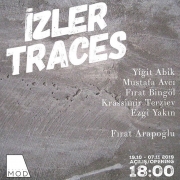“İnsanın ettiği kötülük yaşar ardından,
İyilikleriyse toprağa gider kemikleriyle.”
Shakespeare, Julius Caesar, çev. Sebahattin Eyüboğlu, İstanbul-Remzi Kitabevi, 1999.
Bir tiyatro sahnesi…. Şeytanların, hayaletlerin ve kötü ruhların cehennem ve dünya arasında geliş, gidişlerinin temsilinin zemindeki kapağın açılarak sağlandığı bir sahne, Shakespeare’in Julius Caesar’ından. Yukarıdaki alıntıysa 1988 tarihli bir şarkının ismi, ama bu kez ters yüz edilmiştir: “İnsanın ettiği kötülük devam eder gider.”
Örtük bir metinlerarasılık olarak tarif edilebilecek bu geçişlere biraz daha yakından bakılırsa: sergiye adını veren Iron Maiden heavy-metal grubunun etkilendiği dizeler, – Ayrıca 1984 tarihli Charles Bronson filminin de ismidir ayrıca –, Shakespeare’e ulaşır. Bu tip metinler, kaynağı ne olursa olsun okuyucunun/dinleyicinin onayını beklemektedir. Metinlerarasılık elbette içerisinde belirli bir noktaya kadar alıntılar ya da intihaller içerir. Yani, 1988 tarihli parça, 1599 yılından, Shakespeare’den ulaşır.
İncil’de Vahiyler Kitabı’nda şu sözler yer almaktadır (13:18) “İşte bu hikmet gerektirir: Aklı olan, canavarın sayısını hesaplasın. Çünkü insana ait bir sayıdır. Onun sayısı altı yüz altmış altıdır”. Peki, şeytanın varlığını nasıl yorumlayacağız? İnsan, içindeki şeytanla mı savaşacaktır yoksa şeytanın kendi ruhunu ele geçirmesine izin vermeyecek midir? – Şeytana satılan ruh öykülerini anımsayalım. Ya da şeytanlarımızın bildiği gibi davranmalarına izin mi vereceğiz? Belki de insanlık buna tüm bu iyi/kötü savaşının ana kahramanı olarak karar vermeli. Belki de yapılması gereken içimizdeki şeytanlarla savaşmak ve insan iradesini hür kılmaktır. Fakat, tam da bu noktada Tanrı’nın varlığı sorunsalı karşımıza çıkar: “Tanrı seninle olsun!” temennisi bir yanda dururken, Vincent Van Gogh madenciler için savaşma anında Tanrı’nın varlığını sorguluyor ve inancını kaybediyordu.
Geleceği öngörmeye çalışmak ve kehanette bulunmak… Ahlaki değerler olarak, iyi ve kötü… Ya da insanın tutkuları uğruna bir eylemi gerçekleştirirken tüm etik unsurları devre dışı bırakması…. İşte bu sergi, savaştığımız Tanrı ya da Şeytan ya da varlığı sorgulanan Tanrı ya da Şeytan metaforları üzerinden hareket ediyor. Peki ya Şeytan’ı reddetmek, Tanrı’nın varlığını kabullenmek anlamına gelmezse? Ya da tam tersi?
The Evil That Men Do
“the evil that man do lives after them,
the good is oft interred with their bones”
William Shakespeare, Julius Caesar
A theater scene from Shakespeare’s Julius Caesar… Demons, ghosts, and evil spirits come and go between hell and world, through a hatch that lies on the floor of the stage. The quotation on the top, on the other hand, is the name of a 1988 song, but this time it was turned upside down: “the evil that man do lives after them.”
These transitions can be described as an implicit intertextuality: the verses from the heavy-metal band Iron Maiden, which gave the exhibition its name -also the name of the 1984 Charles Bronson film- go back to Shakespeare.
This kind of texts are waiting for the approval of the reader/listener, regardless of their origin. Intertextuality, of course, to a certain point includes quotations or plagiarisms in it. In other words, the piece from 1988 comes from Shakespeare in 1599.
In the Bible, the Book of Revelations says (13:18) “Here is wisdom. Let him that hath understanding count the number of the beast: for it is the number of a man; and his number is Six hundred and sixty- six”. So, how do we interpret the existence of the devil? Will human beings fight the devil that is in them, or will they not let the devil take over their soul? -Let’s remember the stories about the souls that are sold to the devil. Or are we going to let our demons behave the way they want? Perhaps humanity should decide this as the main hero of all this good / evil war. Perhaps what needs to be done is to fight the demons within us and to free the human will. At this point, however, the question of God’s existence arises: On the one hand, there is “May God be with you,” on the other hand there is Vincent Van Gogh who questioned the existence of God at the time of the fight for the miners and lost his faith.
Trying to foresee the future and prophesize… Good and bad as moral values… Or a person who is violating all ethical values to realize her/his ideals…. This exhibition is based on the metaphor of God or Satan that we fight for, or the metaphor of God or Satan whose existence is being questioned. Well, what if rejecting Satan doesn’t mean accepting the existence of God? Or vice versa?
Küratör/Curator: Fırat Arapoğlu
Artists:
Ahmet Aydın Atmaca
Didem Erbaş & Merve Ünsal
Hülya Özdemir & Ferhat Satıcı
Mustafa Avcı
Olgu Ülkenciler




